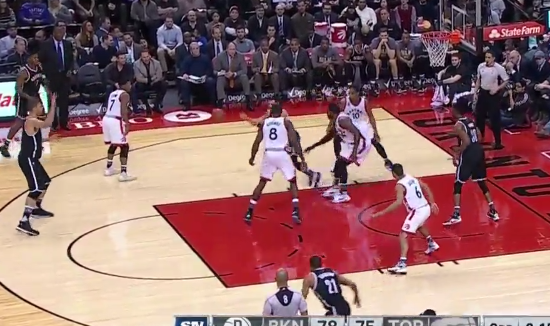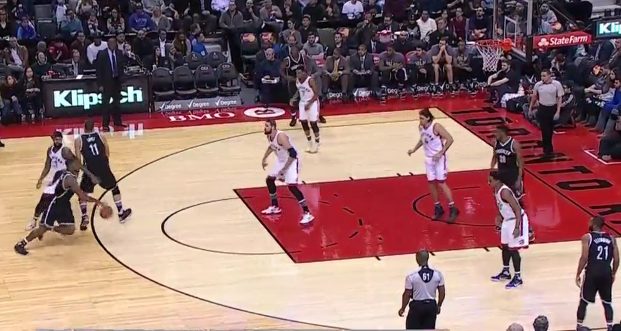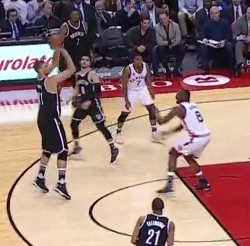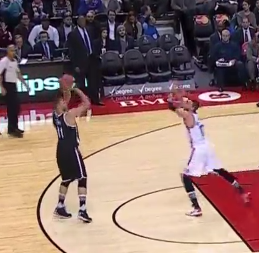Jonas Valanciunas caught a lot of flack from the Toronto Raptors’ broadcast on Monday. Some of it was justified, as Valanciunas had somewhat of a middling game, one that paled in comparison to his play of late and particularly in comparison to his last outing against the Brooklyn Nets, a Jan. 6 game that may have been the best two-way performance of his career. A fair amount of the criticism wasn’t justified, or was at least overstated, as Valanciunas was heralded as the reason that a 42-percent long-two shooter in Brook Lopez got hot in that area.
Since he returned from a 17-game absence on Dec. 28, the discourse around Valanciunas seems to have grown more polarized.
Always a bit of a divisive player, judging off of our comments and mentions, some saw the team performing well with Bismack Biyombo at center and thought that made Valanciunas expendable, or at least highlighted his flaws. A lot of my mailbag and trade column questions have included ways to unload Valanciunas, whether he should go to the bench, or, to a more reasonable degree, how to use him better. Monday’s shaky performance led to more of the same.
Before continuing, I feel the need to reflect on something that’s happened this season, as a matter of some introspection. I would venture that, on the whole, I am not a huge Valanciunas fan or a James Johnson hater. I recognize that Valanciunas is a clunky piece to build with and not an ideal pivot for a modern offense or defense, but also believe he’s talented enough to make up for that, even if he’s never an All-Star. He’s also just 23, two to three years before the window of his prime. In the case of Johnson, I think he’s any under-utilized role player, but not one who I think would start on many teams in the NBA and not one who I believe is deserving of 25 minutes a night regardless of matchup. But the sheer volume of anti-Valanciunas and pro-Johnson comments we receive makes it seem as if I’m biased toward each – because I sit somewhere in the middle and try to argue people at the poles back toward the middle, it can sometimes seem like I’m a wild Valanciunas apologist or a student at the Dwane Casey School of James Johnson Management.
Neither of those things are true, though what follows certainly reveals that I’m quite optimistic about Valanciunas’ play of late.
Defending Brook Lopez
The reality is, Valanciunas didn’t play that poorly Monday. It wasn’t his best outing by any means, and he was taken out of the game some on offense, but his defense was hardly objectionable. He didn’t do nearly as well against him as on Jan. 6, when Lopez operated mostly from the post rather than the high mid-range.
A lot of Lopez’s scoring fell on the system, which is designed to invite mediocre shooters to shoot inefficient shots. Biyombo, who did a better job on Monday, guarded Lopez in mostly the same way as Valanciunas, sagging well off of him to help on dribble-penetration if Lopez was outside the paint.
Valanciunas needs to improve how quickly he closes out on shooters, to be sure. He is a little slow making the decision to get out and contest, and because he doesn’t have high-end north-south speed, stretchier bigs have presented somewhat of an issue. But right now, Casey’s scheme is designed to invite those shots, because they’re terrible shots, for the most part. The team shouldn’t abandon their scheme when jump-shooting bigs like Lopez or Jason Smith get hot on bad shots, they just need to tighten up the execution some.
There’s an argument to be made that Casey will need to tweak the system some depending on playoff matchup. If an opponent lacks dangerous drivers or pick-and-roll guards, and/or if they have an effective pick-and-pop big, the Raptors should probably be a little less conservative in their drop-backs. Over the course of 82 games, though, I’m entirely in favor of opting for scheme consistency in order to improve cohesion and execution.
Guarding the pick-and-roll
The by-product of dropping back like the Toronto bigs do is that it helps seal off the restricted area. That’s the entire point – the rim is the most efficient place on the floor to shoot, and the Raptors want to keep teams away from there, or at least make life difficult when opponents get there.
So far, the scheme tweak is mostly working. The Raptors allow the fourth-fewest field-goal attempts in the restricted area per-game (25) and opponents have shot a below-average 57.3 percent in that area. The net result is that only one team, the San Antonio Spurs, has allowed fewer restricted-area field-goals per-game than the Raptors. The Raptors play a slow pace, so they’ll look slightly better by per-game stats, so consider this, too: The only team better than the Raptors at defending pick-and-roll ball-handlers is the uber-lengthy Milwaukee Bucks. Ball-handlers are scoring just 0.73 points per-possession against the Raptors,
Want further evidence Valanciunas is coming along just fine on defense? The Raptors are league’s best post-up defense, surrendering just 0.71 points per-possession, and Valanciunas ranks in the 98th percentile over 55 defensive possessions.
Despite his poor rim-protection numbers – he’s cost the team half a position-adjusted point per 36-minutes, per Nylon Calculus – Valanciunas isn’t playing poorly on the defensive end. Compared to Biyombo, who is an elite rim-protector and seals off the entire baseline, sure. But Valanciunas grades well, even elite, by contest rate and at-rim deterrence, he just needs to improve at actually stopping or altering shots when he contests. Perhaps encouraging: Valanciunas is averaging two blocks since returning and has 17 over his last seven games.
Another key area for Valanciunas to improve moving forward is handling both the ball-handler and the dive man, learning to find the appropriate space between the two. The Raptors grade out poorly covering the roll-man, and Valanciunas in particular has struggled over 35 defensive possessions. (Biyombo is roughly average.) Here’s an example of exactly how Valanciunas should mind Lopez while also helping at the rim:
[gfy]RightDamagedAmbushbug[/gfy]
He navigates the space perfectly there and times his help such that a dump-off would be tough. This next play isn’t the same situation, but again shows some improved instinct and spatial awareness:
[gfy]SleepyFatalCougar[/gfy]
Overall defensive impact
Despite improved play, the Raptors remain slightly better on the defensive end with Valanciunas on the bench. That’s not all that surprising given that Biyombo’s primary calling card is defense and that Valanciunas plays the bulk of his minutes against starters. What’s encouraging, though, is that the effect isn’t very pronounced this season.
It’s not ideal that Valanciunas is a negative on defense but the effect is small enough that he remains a major net positive because of his offense. He’s also an elite rebounder, ranking just behind Biyombo in adjusted rebounds per-minute. (Seth Partnow is also experimenting with a Rebound Value Index that currently suggests Valanciunas’ rebounds could be more valuable than his rebounding total by 10.5 percent, a very high mark, though one would expect the real value of said rebounds to reveal itself in the team’s on-court performance over time, so maybe this is already accounted for in the numbers.)
Note: There’s noise in on-off court data, and I would perform a WOWY analysis, except the Raptors lineups have been shredded into tiny samples because of injuries to Valanciunas and DeMarre Carroll.
Quick cuts and smart passes
That table above? Not the greatest, but Valanciunas has helped lift the offense by 7.1 points per-100 possessions, so his overall net impact has been a major positive. It’s tough to separate his impact from that of Kyle Lowry, as Valanciunas has hardly played without Lowry and the team, nearly to a man, does better with Lowry than without.
Regardless, Valanciunas is playing well offensively, even if his overall numbers are modest. His post-up offense has strangely declined from its elite level a year ago and he’s scarcely used as a dive-man (barely once per game despite being highly effective on those touches), but he’s averaging 12 points on 53.6-percent shooting, grabbing 3.3 offensive rebounds per game, and maintaining strong efficiency metrics even as his usage rate has climbed (barely) north of 20 percent.
One way he’s been able to continue to score easy, efficient buckets is by emerging as a cutting threat. When Carroll or Johnson are on the floor, the Raptors can screen a big with a wing, providing Valanciunas a window for a cut, which creates either a mismatch or deep post position or both.
[gfy]HandmadeGiddyBrownbutterfly[/gfy]
Here’s a worse example, as the Nets niff the play out and record quickly, but you can still see the action and where it could work against a less suspecting team.
[gfy]ShinyMiniatureGnatcatcher[/gfy]
Valanciunas currently ranks in the 85th percentile for offense off of cuts, shooting 67.9 percent on those opportunities and drawing a foul 16.4 percent of the time.
There’s long been evidence that the Raptors should involve Valanciunas more. The counter has been that Valanciunas can gum up the offense, his post-ups representing a black hole that’s sure to result in a shot or turnover. That’s fair, if a somewhat narrow way of thinking of those possessions, but the narrative doesn’t quite hold of late – Valanciunas’ turnover rate remains roughly average for a center, but his assist rate has creeped up from woeful to almost tolerable. The issue has never been passing ability so much as awareness, and Valanciunas is beginning to show progress in that regard, dishing nine dimes over his last four games.
[gfy]AngryShrillAustralianfreshwatercrocodile[/gfy]
A season ago, Valanciunas averaged 26.6 passes and 17.2 frontcourt touches, which he held for 1.64 seconds on average, good for 0.9 potential assists. This year, that’s up to 32.7 passes and 21.7 touches with a 1.57-second average touch time, good for 1.3 potential assists. The percentage of his passes that result in potential assists has climbed from 1.8 to 2.5, too.
Those are tiny improvements, and who knows if they’ll last given the small changes and the small sample in which they’re occurring. But I’m choosing to be encouraged by his recent play. He’s averaging 2.1 potential assists since his return, with 4.7 percent of his passes resulting in potential assists.
This doesn’t mean he’s suddenly Joakim Noah or Greg Monroe, but if it speaks to a growing awareness on the offensive end, it will open up how and how often the team can use him on offense.
A Sim Bhullar play for Valanciunas?
Not entirely related, here’s a pet play of Raptors 905 I’d like to see the Raptors try out. Axel Toupane, an aggressive rim-attacking wing, sends a high post-entry pass to Bhullar and immediately follows the ball, cutting around the big man. Toupane is fast and Bhullar’s size causes tough decisions (and routes) for the defense, and Toupane gets cheap looks at the rim once or twice a game because of it.
[gfy]ShadySaltyGoldfish[/gfy]
Bhullar isn’t as skilled a passer as Valanciunas, and while he’s bigger, one would think his screen-setting and offensive talent would make the play just as difficult for a defense. Johnson fits the mold as the type of wing who could run this with Valanciunas, as would Carroll, when healthy. They’ll also run a similar action off of sideline out-of-bounds plays, sometimes with a guard involved to set up the post-entry.
[gfy]BestRichAztecant[/gfy]
[gfy]MistyVigilantHapuka[/gfy]










